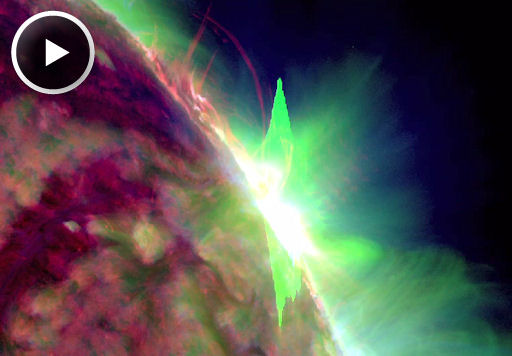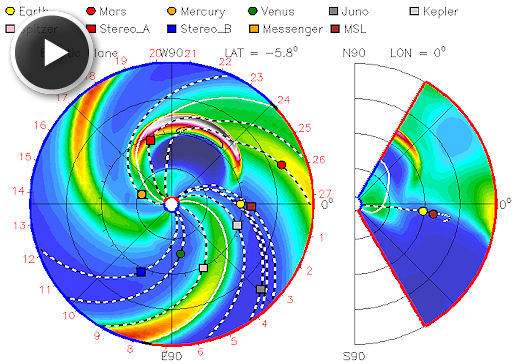RADIATION STORM: Accelerated by yesterday's X-flare, energetic protons from the sun are swarming around Earth on Jan. 28th. The radiation storm ranks S2 on NOAA scales, which means this is not a severe storm. Nevertheless, it can still affect spacecraft and satellites at the nuisance level. For instance, this coronagraph image from SOHO is clouded by protons hitting SOHO's onboard digital camera.
ANNULAR SOLAR ECLIPSE: A "ring of fire" solar eclipse is coming to the USA this spring. It's the first annular eclipse visible from the contiguous United States in almost 18 years. Science@NASA has the full story and a video.
\
X-FLARE (UPDATED): Departing sunspot 1402 unleashed an X2-class solar flare on Jan. 27th at 18:37 UT. NASA's Solar Dynamics Observatory recorded the extreme ultraviolet flash:
Sunspot 1402 is rotating onto the far side of the sun, so the blast site was not facing Earth. Nevertheless, energetic protons accelerated by the blast are now surrounding our planet, and an S2-class radiation storm is in progress.
The explosion also produced a spectacular coronal mass ejection (CME). A movie from the Solar and Heliospheric Observatory shows the cloud racing away from the sun at 2500 km/s or 5.6 million mph. Update: Work by analysts at the Goddard Space Weather Lab shows that the CME will just miss Earth when its edge passes by our planet on Jan. 30-31. Click to view an animated forecast track:
The cloud will deliver a glancing blow to Mars on Feb 1st and a nearly-direct hit to NASA's STEREO-Ahead spacecraft on Jan. 29th. Solar flare alerts: text, voice.

![]()
Solar wind
speed: 277.5 km/sec
density: 0.1 protons/cm3
explanation | more data
Updated: Today at 1559 UT
![]()
X-ray Solar Flares
6-hr max: C1 1535 UT Jan28
24-hr: C2 0118 UT Jan28
explanation | more data
Updated: Today at: 1600 UT
![]()
![]()
![]()
Daily Sun: 28 Jan 12
![]()
![]()
None of the spots on the Earthside of the sun pose a threat for strong flares. Credit: SDO/HMI
![]()
![]()
![]()
Sunspot number: 39
What is the sunspot number?
Updated 26 Jan 2012
Spotless Days
Current Stretch: 0 days
2012 total: 0 days (0%)
2011 total: 2 days (<1%)
2010 total: 51 days (14%)
2009 total: 260 days (71%)
Since 2004: 821 days
Typical Solar Min: 486 days
Updated 26 Jan 2012
The Radio Sun
10.7 cm flux: 128 sfu
explanation | more data
Updated 26 Jan 2012
![]()
![]()
![]()
Current Auroral Oval:
![]()
Switch to: Europe, USA, New Zealand, Antarctica
Credit: NOAA/POES
![]()
![]()
![]()
Planetary K-index
Now: Kp= 1 quiet
24-hr max: Kp= 2 quiet
explanation | more data
![]()
Interplanetary Mag. Field
Btotal: 4.1 nT
Bz: 3.3 nT south
explanation | more data
Updated: Today at 1606 UT
![]()
![]()
![]()
Coronal Holes: 27 Jan 12
![]()
![]()
Solar wind flowing from the indicated coronal hole should reach Earth on Jan. 28-29. Credit: SDO/AIA.






